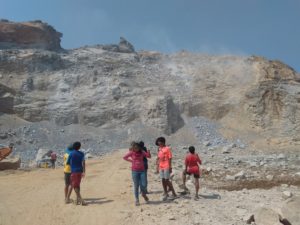Nestled as we are in Magadi Taluk on a verdant twenty plus acre campus, it can be hard for us to imagine a world devoid of greenery, fresh air and quiet. As part of our Environmental Management course with the 9th grade children, a colleague and I thought it worthwhile to explore a nearby granite quarry, to experience first hand, some aspects of this form of mining.
As we entered, we were all struck by the assault on our senses. Rubbing their eyes, choking on rock dust the children pointed to the overburden (of waste from the quarry) and greying shrubs (the few that remained) clothed in quarry dust. We had entered a moonscape – hills of rock occasionally clouded by a pall of dust as a delicately balanced earthmover pummeled bundles of stones down the hill in continuous avalanches. Giant drill heads attacked the rock with gusto and trucks carried away stones of different sizes to a processing area. And here, deeper, and further from the main road, the air took on a different quality completely. Our bodies, hair, tongues, nostrils, eyes and ears were sprayed and coated with dust. What was once a magnificent hill, much like that we were so used to climbing on walks from school, now coated us, clung to us, in a completely different form, unrecognisable from its lofty origins.
“How do these workers live here?”, we wondered.
“What kind of lung diseases might they have? What kind of breathing difficulties? Where was their basic safety equipment?”
 And then of course, a reflection, that this rock dust was a familiar sight in trucks on roads leading to Bangalore, a metropolis less than fifty kilometres away. The same rock dust that builds our houses, our offices, our entertainment and public service venues. It has sadly become an alternative to the fast depleting river sand which has been (illegally, perhaps) mined for decades from the smattering of stream beds in this region.
And then of course, a reflection, that this rock dust was a familiar sight in trucks on roads leading to Bangalore, a metropolis less than fifty kilometres away. The same rock dust that builds our houses, our offices, our entertainment and public service venues. It has sadly become an alternative to the fast depleting river sand which has been (illegally, perhaps) mined for decades from the smattering of stream beds in this region.
Some quarries in this area are said to be in the watershed of the Arkavathi River which emanates from Nandi Hills. This river, dammed at Thippagondanahalli where it meets the Kumudavathi River, was once, and is still occasionally, a source of water to western Bangalore. A source of recharge for bore wells, and water for those along its course.
And so again, we come to core issues in environmental management, whether the context is a big dam, a mine, or a quarry: Who pays? Who benefits? And at what environmental and social cost?
